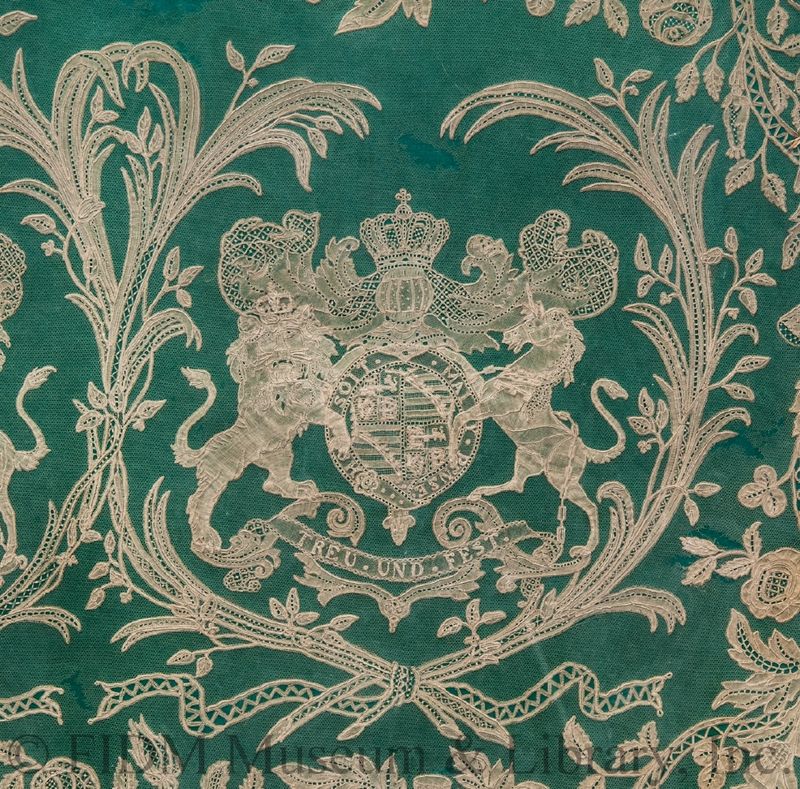The FIDM Museum is in the final months of a major fundraising campaign to purchase the Helen Larson Historic Fashion Collection, a private collection of 1,200 historic garments and accessories from four centuries. Each Friday, this blog will present an exquisite piece from the Larson collection.
 Lace roundel
Lace roundel
England
1851
Helen Larson Historic Fashion Collection
Although Helen Larson collected clothing primarily, she could not resist acquiring a few outstanding examples of the textile arts. This lace roundel uniting the coats of arms of Queen Victoria and her beloved husband, Prince Albert, undoubtedly appealed to her because of its royal connections. Tudor roses for England, thistles for Scotland, and shamrocks for Ireland–as well as majestic oak leaves, acorns, and palm and olive branches–surround the coats of arms, all backed by a piece of green silk satin and ensconced in a gilded oak frame. The ornate scrollwork and natural motifs are characteristic of Honiton lace, a bobbin lace first produced in Devon in the seventeenth century and used for Queen Victoria's 1840 wedding dress and veil. (On Sunday, Princess Charlotte was christened in an exact replica of the Honiton lace christening gown made for Queen Victoria's first child in 1841.)
 The Royal coat of arms used by the Sovereign of the United Kingdom from Queen Victoria’s ascension in 1837 to the present day
The Royal coat of arms used by the Sovereign of the United Kingdom from Queen Victoria’s ascension in 1837 to the present day
The roundel came to the FIDM Museum with an uncertain provenance: was it a wedding gift to the royal couple, or part of the Honiton display at the Great Exhibition of 1851? Research by FIDM Museum Curator Kevin Jones established that it was designed for the Great Exhibition by T. Sharp and manufactured by John Tucker, who employed more than 500 lacemakers in Branscombe, East Devon. Kevin presented his findings at the prestigious Anglo-American Conference of Historians held last week in London. In order to illustrate the scale of the piece–which measures 44 inches tall by 50 inches wide, including its frame–Kevin showed a photo of himself and Associate Curator Christina Johnson posing with the lace.
 Christina Johnson and Kevin Jones
Christina Johnson and Kevin Jones
One final mystery remained: how did a royal family heirloom find its way to a private collector in Whittier, California? Larson bought the piece in 1977 from British dealer Doris Langley Moore, who had purchased it during World War II from the Officers’ Families Fund, a charity founded in 1899 to provide relief to widows and children of military casualties. During World War II, the organization decided to collect heirloom lace, exhibit it, and sell it to raise funds. Both Queen Elizabeth (the Queen Mother) and the Victoria & Albert Museum donated lace from their collections to the cause. The roundel likely came from one of those sources. Today, British antiquities laws would never allow this important artifact to leave the country, but in 1977, Larson pronounced herself “delighted beyond words to have something of such historic significance."
 The personal coat of arms of Prince Albert of Saxe-Coburg and Gotha
The personal coat of arms of Prince Albert of Saxe-Coburg and Gotha
Helen Larson spent 50 years assembling her collection; now, it is in danger of being dispersed forever or absorbed into another private collection, inaccessible to students, researchers, and the general public. The FIDM Museum needs your help to save the Larson collection. You can make a contribution of any amount online or by mail, or join our #4for400 social media campaign. Donations are tax deductible; if your company has a matching gift program, your support will go even further. The FIDM Museum has until the end of 2015 to finish raising the necessary funds, so now is the time to join the campaign and help make fashion history.


My maternal grandmother used to make lace…nothing quite as intricate as this I think, but a fascinating skill nonetheless. This one is amazing.